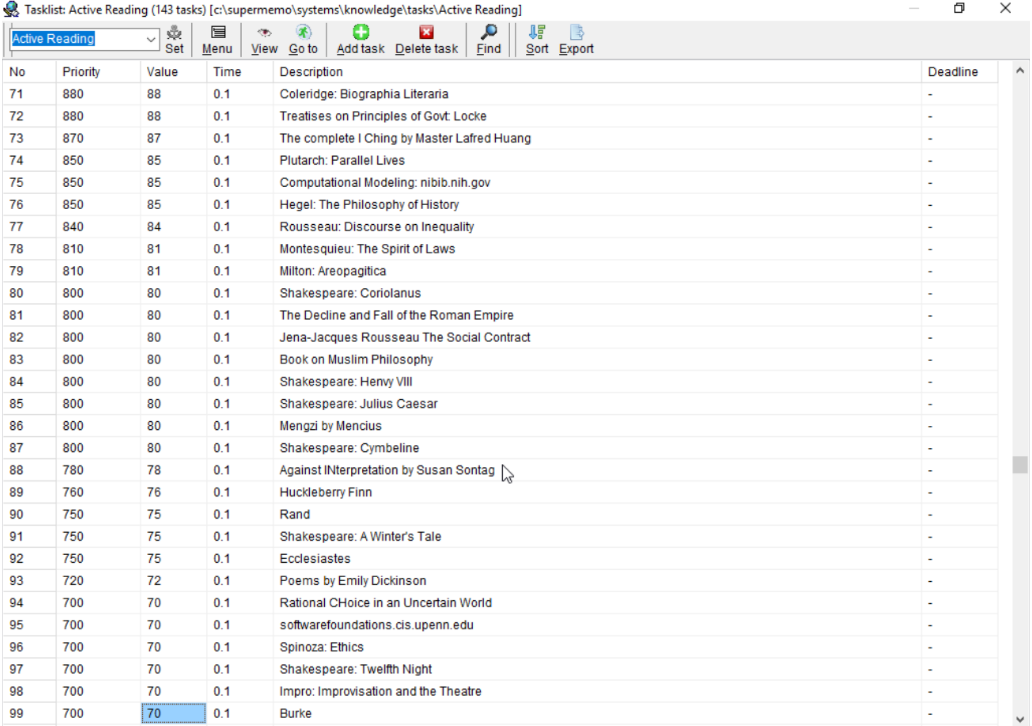My Reading Systems
Civilization boasts a surplus of interesting books and allows not nearly enough time to read. Bookworms can often only read each interesting book long after they discover it, so they create reading lists that preserve titles during the delay.
The problem with simply adding a newly-discovered book to the end of the list is that some books are more important or interesting than others. Ideally, you want to order your list so that you read the best books first. However, for anyone who’s in the habit of adding to it every day, the list can grow so large that sorting it by hand is daunting.
After many iterations I’ve arrived at a solution that works moderately well. Since this solution seems to be somewhat unusual, I wanted to record it and put it somewhere public in the hope that it will help others.
Reading
There is more than one way to read a book. I read things in four ways:
The first way is audio. The main advantage is portability: you can read while exercising, during a commute, or anytime when the task at hand doesn’t demand complete attention. The downside is superficiality: you can’t take notes and reviewing a part you miss is difficult. Both factors lead to low retention and comprehension.
I typically only read fiction and unimportant nonfiction via audio, since I don’t care about memorizing those books.
The second way is “passive reading”. Passive reading happens whenever you consume the information without interacting with it. This is the reading mode for most people. I do this on my phonei when I am waiting in line or otherwise have downtime.
Active reading requires interacting with the text. There are an infinite variety of ways to do this: I go through the book and summarize important arguments, highlight interesting evidence, note things to research, and analyze stylistic choices. This leads to better comprehension and helps with generating notes for Anki and Supermemoii if I later wish to memorize the book.
There are some books that I load into Supermemo from the beginning: I only do this with the few books that I want to embed deep in my mind, since reading an entire book with Supermemo is a long process. During incremental reading, I break the book down into constituents and massage its content until I can memorize it with spaced repetition. This allows for potentially permanent content retention.
At any given point, I’m reading four books: one book by each method. I set out a small amount of time each day for active reading and some more time for Supermemo.
Sorting
How to decide what books to read first? How to decide the way to read them?
Supermemo has a feature called a “tasklist.” It’s designed to accommodate ordered, non-time-bounded to-do lists by allowing you to assign a value (usefulness) to a task and an amount of time required for that task. Supermemo will sort the tasks in the list based on value over time.
Choosing how to read the book boils down to how much I want to memorize the content. There is usually little reason to memorize fiction, so I consume it through audio. Certain important nonfiction might call for active reading. Textbooks are usually slotted in active reading or, if they are very important, in Supermemo. There is a separate tasklist for each way to read.
Whenever I encounter a worthwhile book, I access the appropriate tasklist and, in the value field, make a probabilistic prediction: on the day I die, how likely am I to regret not having read this book? I ignore the time field.iii

The Active Reading Tasklist. Note the percentage in the value field.
Though I use Supermemo, any software that can sort items in a list by numerical value can do this.
Effects
I also use this system to manage all worthwhile content that isn’t connected to a specific goal. When I hear of a good blog post or podcast, for example, I also add it to one of these four lists.
This system is basically the opposite of a “feed” that delivers recently-made content that I’m interested in. It therefore lacks the major problems of a feed: distraction, reload addiction, and superficiality.
At the same time, it’s terrible at keeping me informed about recent events because priority is based only on long-term value. This is okay for me since I don’t really care about recent events except for recent AI developments. In the future I may set up a feed to target AI advances. Of course, I will need to be careful to balance my time between the feed and the reading lists so that neither system consumes the other.
Conclusion
Reading is just one aspect of self-education. Though reading educates, creation is a much better teacher than consumption. Knowing this, I try to limit my reading time to make room for creation. We have extraordinarily little time to read and there’s so much content out there, we must manage the precious time we do have incredibly carefully.
Don’t read voraciously. Everyone voraciously consumes information nowadays. Read carefully and read the right things. One great book well read is better than ten thousand hollow tomes skimmed and thrown away.
Footnotes
i I use the android e-reader ReadEra to read on my phone. For audio, I use TTS Reader
iiThese are incremental review programs. Basically, I make flashcards from the book that the software reminds me to review in increasing intervals over time. Read more about Anki and Supermemo
iii Why keep the time value constant? Why not change it in proportion to the length of the book? Mostly because looking up the number of pages in each book before adding it would add too much friction to the process. One avenue for improvement is to make a script that automatically looks up the page number of every book added to it.